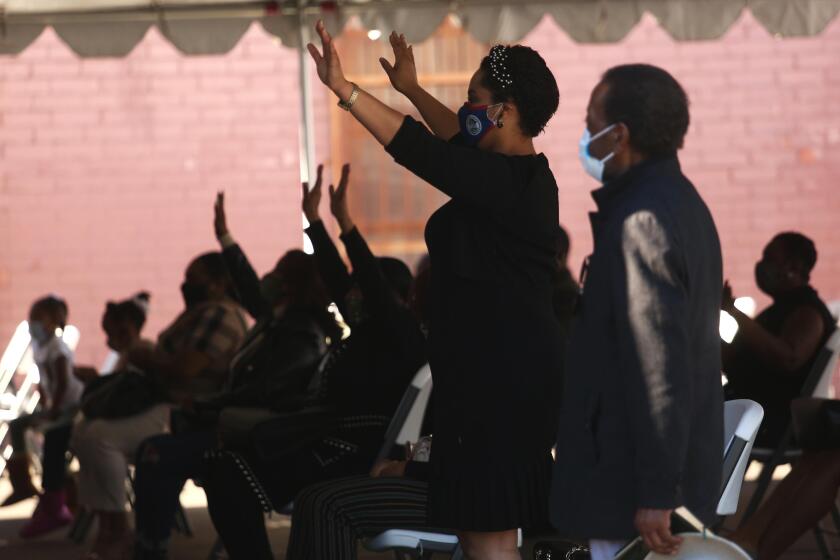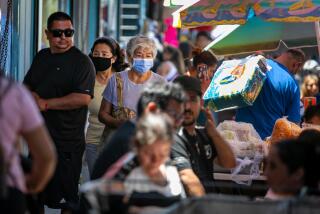San Fernando Valley’s Latino neighborhoods staggered by L.A. County virus outbreak
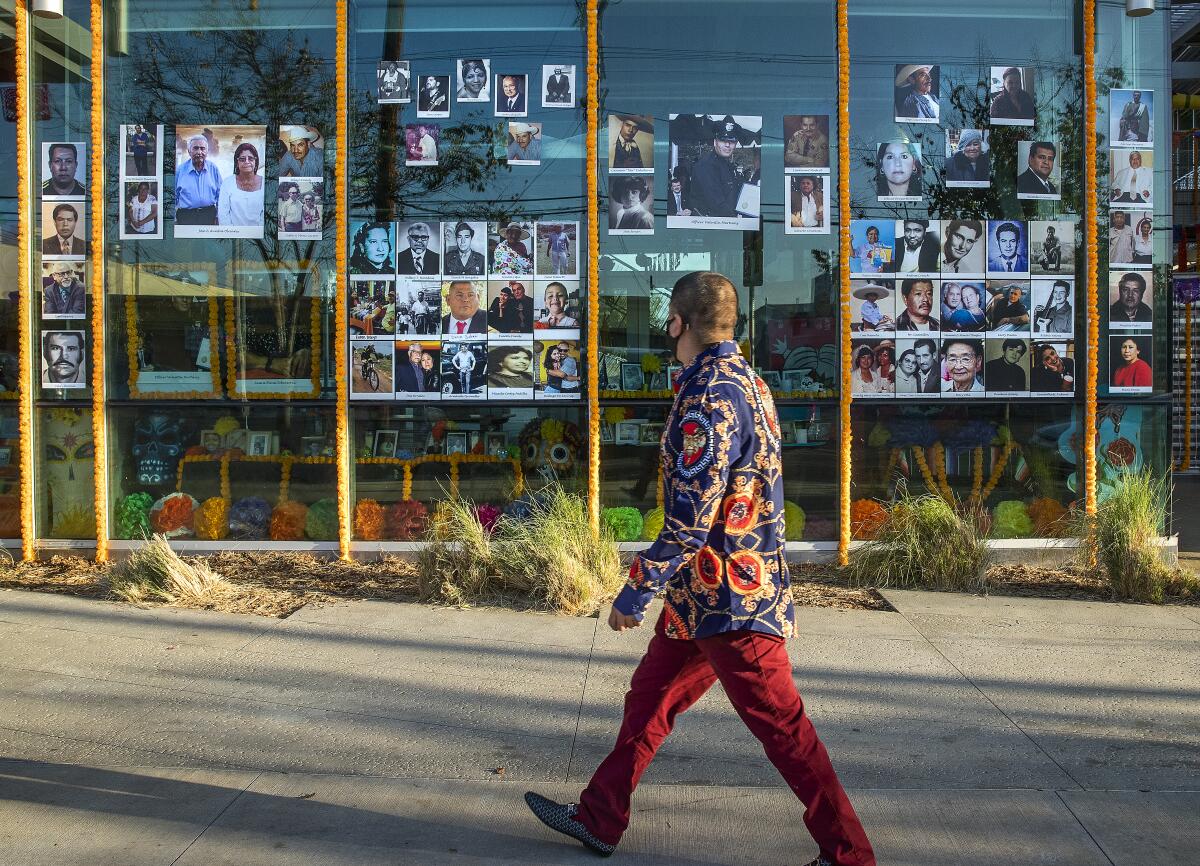
- Share via
There was no way for Carolina Sanchez to isolate from her family after testing positive two weeks ago for the coronavirus.
She lived in a room with her four children at a Vagabond Inn in Sylmar in the northeast San Fernando Valley. They and Sanchez’s sister, who looked after the kids, also contracted the virus. This was the cost of being a low-wage worker living in crowded conditions. It was a cost exacted from Latinos above almost any other group.
Experts say the failure to protect Latino essential workers has contributed to California’s mid-summer spike of the coronavirus.
“It is scary knowing that you could go out there and get sick again,” Sanchez said.
With coronavirus cases and hospitalizations reaching unprecedented levels in California, the pandemic is once again stalking low-income, working-class, majority Latino neighborhoods with particular aggressiveness, according to a Times data analysis.
The Latinx experience chronicled
Get the Latinx Files newsletter for stories that capture the multitudes within our communities.
You may occasionally receive promotional content from the Los Angeles Times.
In Los Angeles County, a COVID-19 hotbed, five of the 25 communities with the highest infection rates are in the northeast San Fernando Valley — in areas that are home to large numbers of “essential” workers at prime risk of infection and include ZIP Codes with high rates of crowded housing. Some are plagued with pollution and are encircled by three bustling freeways, a railroad line and dozens of industrial facilities, as well as a power plant that for three years had been leaking methane.
Near the top of this troubling list is the city of San Fernando, which has an infection rate two times greater than that of L.A. County as a whole. Its rate as of this weekend was 1,044 cases per 100,000 people, compared with the county’s rate of 496 per 100,000, according to government records. Also badly hit is the L.A. neighborhood of Pacoima, which has an infection rate of 993 per 100,000 people.
The Valley neighborhoods Arleta, Sylmar and Van Nuys are also on that list.
Although 11% of homes in L.A. County are considered crowded, some of the neighborhoods with the highest rates of infection — including Pacoima and Arleta — have rates of crowding twice as high, according to a Times analysis.
Gov. Gavin Newsom has announced a stay-at-home order affecting most of California.
The trend reaches beyond Los Angeles.
A Times analysis of communities statewide showed that other heavily Latino areas are among the hardest hit by the pandemic. Such communities along the 10 Freeway corridor in San Bernardino County have among the state’s highest case rates, including in Bloomington, Colton, Fontana, Montclair, Rialto and San Bernardino, as well as those in the high desert, such as Adelanto, Hesperia and Victorville.
They stretched statewide, in border communities in San Diego and Imperial counties, such as Calexico and San Ysidro; agricultural communities in the Central Valley and Coachella Valley; and a community in Berkeley, where an outbreak has spread among hundreds of workers at the Golden Gate Fields racetrack.
Latino workers have the highest rate of employment in essential frontline jobs where there’s a higher risk of exposure to the coronavirus, according to the UC Berkeley Labor Center; 55% of Latinos work in such jobs, and 48% of Black residents do as well, compared with 35% for white residents.
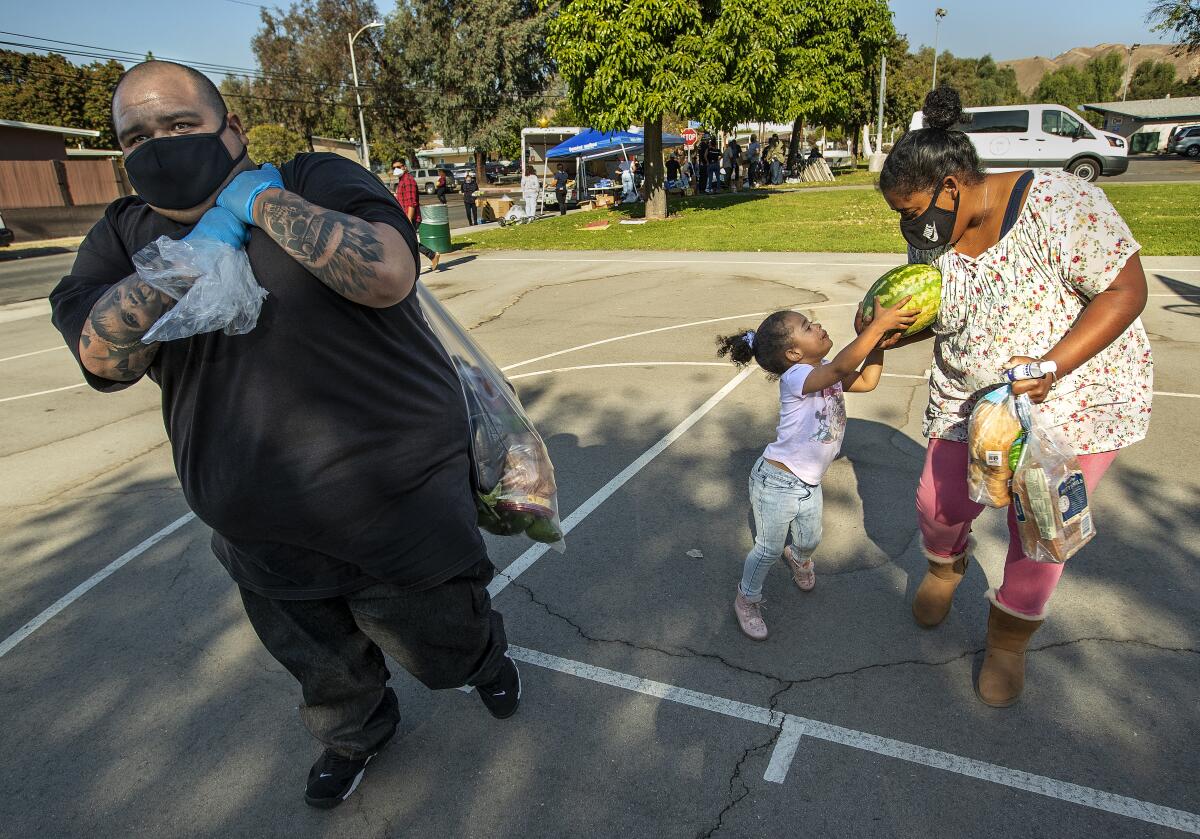
As of Nov. 7, Latino residents were being hospitalized at an age-adjusted weekly rate of about 10.5 per 100,000, or more than double the rate of 3.8 hospitalizations per 100,000 white residents. (Statistics that are adjusted to account for age differences among racial and ethnic groups provide more meaningful comparisons, according to epidemiologists.) The disparity in death rates had been declining but could worsen as the death toll rises.
In July, the nonprofit Meet Each Need With Dignity, which runs an emergency food bank in Pacoima, began conducting a housing survey of new clients and collected data on 414 households in the northeast San Fernando Valley. The survey indicated that 41% of those residents shared a household with another family, and more than 30% lived in a back house, room or mobile home. About 8% lived in a garage.
“Most live in some sort of substandard [housing],” said Janet Marinaccio, president and chief executive of MEND. “There can be a family of six living in a garage. They’ll double up and triple up. You might have four families, one in each bedroom and living room.”
The region reported more than 27,000 new COVID-19 cases over the last two months. The area now accounts for 19% of new infections, although it comprises just 12% of the countywide population, analysis shows.
This week, the L.A. County Department of Public Health expanded testing in this corner of the Valley. It also increased outreach efforts in the Latino community with the help of promotoras, trained lay health workers who can provide information about the pandemic to the public, including in Spanish.
Early last month, the county dedicated about $30 million to the program as cases of the coronavirus soared.
The alarming number of people becoming infected in the San Fernando Valley is due to a variety of reasons, including colder weather forcing more people to cluster indoors. Barbara Ferrer, the L.A. County director of public health, believes a false sense of security has also settled in among a lot of people.
“I think it may more reflect the gatherings and the parties, the mixing with people not in your household,” she said. “And one problem with this virus is, once the rates go up, it can kind of feed upon itself.”
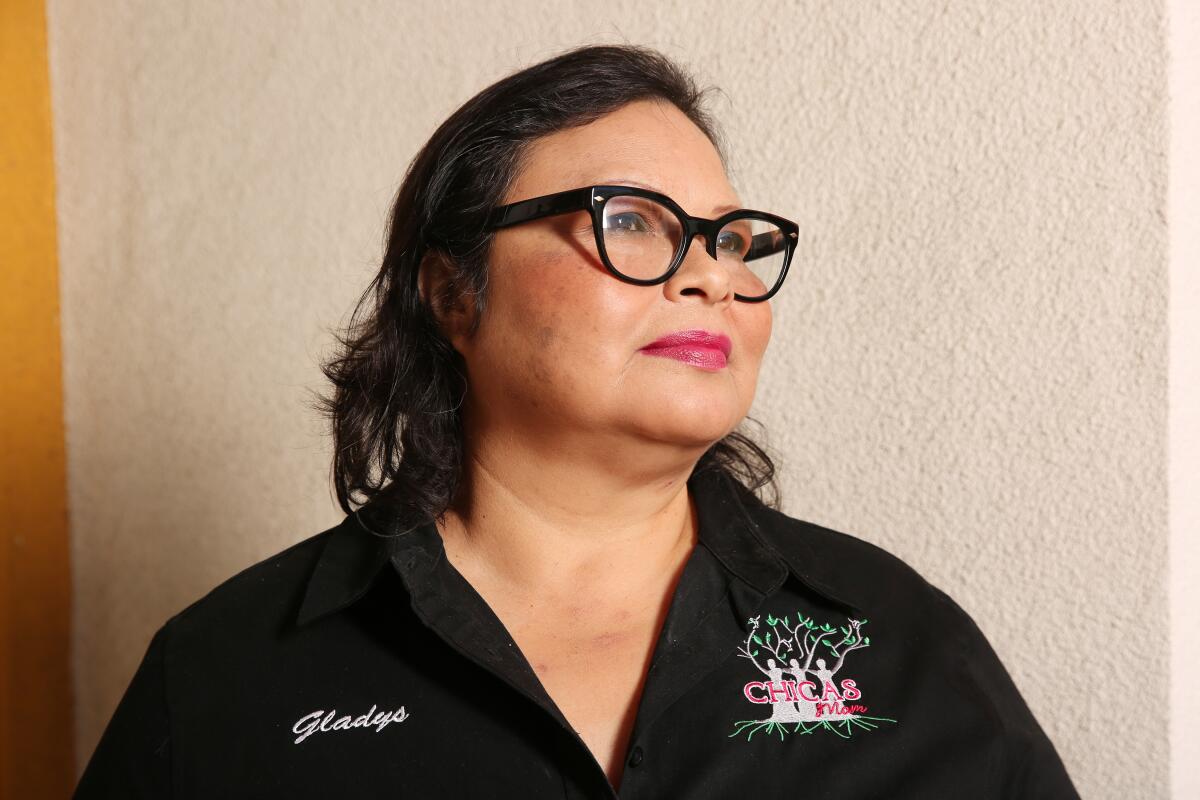
Gladys Ayala, co-founder and chairwoman of Chicas Mom Inc., a nonprofit that aims to empower and educate women in the Valley, said shame and inconsistent information from the White House increased doubt about the seriousness of the coronavirus. She said she tested positive for the coronavirus in May and infected her family.
“The president had a lot to do with this,” she said. “He minimized this so much that people didn’t believe it.”
Ayala said she had all the classic symptoms, losing her sense of smell and taste and feeling fatigued. Her husband, who is diabetic and has high blood pressure, was hospitalized for three weeks. They both recovered. Her two children, ages 19 and 15, tested positive but didn’t develop any symptoms.
Sanchez, 28, the mom living with her kids in a motel, said she had returned from working a shift at the 99 Cents Only store when she felt sick. She developed chills, lost her appetite and had trouble breathing. After three days in bed with a fever, she went to get tested and found out she had COVID-19.
“I had always tried to stay safe with my mask on,” she said. “I wear my gloves and keep my distance as people come in.”
For two weeks, she quarantined with her four children — ages, 3, 4, 5 and 8 — and her sister in their room. She said none of the children developed symptoms.
The situation was another marker in Sanchez’s hard life. She’s a domestic violence survivor, and for five months she lived in her car with her children after being evicted from their home.
A year and a half ago, she enrolled in an L.A. housing program that pays for a large portion of her rent at the hotel. Sanchez says she pays about $275 a month.
Family members come by to drop off meals outside her motel room. She said the children had grown antsy because they wanted to go outdoors. She said her 8-year-old, Nathan, who is attending classes online, had a hard time concentrating on school.
“The space is limited, so he has his brothers jumping up and down in the background,” she said. “I have teachers call me and tell me Nathan needs to be in a quiet place to do his homework.”
Coronavirus cases and hospitalizations have hit unprecedented levels in California, and officials expect conditions to deteriorate rapidly in the coming weeks.
When the latest surge in COVID-19 cases erupted, 34-year-old Pacoima resident and community activist Silvia Anguiano picked up the phone to reach out to nonprofits like Homies Unidos, 2nd Call and Partido Nacional de La Raza Unidas.
Anguiano was particularly worried about how the pandemic could tear through the community of immigrants living in the country illegally.
“One out of two immigrant people in the community don’t know where to get tested, so we need to bring some kind of education … to our food distribution” program, said Alex Sanchez, 49, an organizer and co-founder of Homies Unidos, a gang-intervention nonprofit that also aims to empower youth.
Two weeks ago, the group had its first food giveaway event outside Hubert H. Humphrey Memorial Park in Pacoima. Black and Latino volunteers wore masks and gloves as they unloaded boxes filled with milk, hummus, watermelons and vegetables while cumbia music blasted from a speaker in the background.
The event caught the attention of people driving by and residents living around the park, who arrived with shopping carts and baby carriages. They were all given loaves of bread and bottles of hand sanitizer while volunteers filled large bags with groceries.
When the group had its second food giveaway at the park on Thursday, the lines stretched around the block. Melba Martinez, 45, who is from Honduras, walked about three miles from her apartment in Pacoima with her 12-year-old daughter, Daniela, to pick up food. Martinez lost her job cleaning houses in March when the pandemic first started to bear down in Southern California. That work paid her about $2,000 a month.
Since then, Martinez has fallen behind on her monthly $1,500 rent. She was forced not only to borrow money from her sister to make rent, but also to depend on church food distribution sites to feed her two children.
Martinez says she lives in a state of constant worry.
The Latinx experience chronicled
Get the Latinx Files newsletter for stories that capture the multitudes within our communities.
You may occasionally receive promotional content from the Los Angeles Times.
She left her homeland for a better life. But now, it’s hard to imagine that goal has been accomplished. Martinez said the apartment building she lived in seemed ripe for the spread of the coronavirus. Many families live in cramped conditions, and she knows that some people have become infected.
“My neighbor upstairs lives with two other families, and she told me one of the people who lives there got … everyone sick,” she said. “Downstairs from me are two families living in an apartment, and they’ve all gotten infected.”
Martinez wonders whether the number of people who have the coronavirus is actually higher than people know. She said some people had made an earnest plea to her: “They’ve all told me, ‘Please don’t tell anyone that I got COVID-19.’”
Times staff writers Rong-Gong Lin II, Ryan Menezes and Sean Greene contributed to this report.
More to Read
Sign up for Essential California
The most important California stories and recommendations in your inbox every morning.
You may occasionally receive promotional content from the Los Angeles Times.




